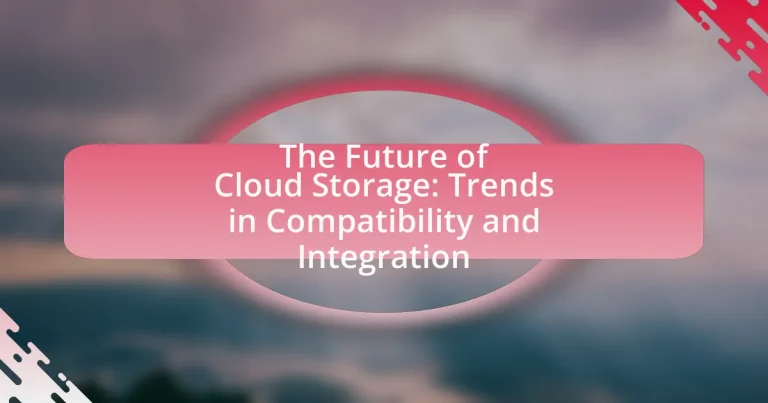The article focuses on the future of cloud storage, specifically examining trends in compatibility and integration. It highlights the growing adoption of multi-cloud strategies among enterprises, the importance of API standardization for seamless data transfer, and the role of emerging technologies like artificial intelligence and quantum computing in enhancing cloud storage solutions. Key challenges such as data security and compliance are also discussed, along with practical steps organizations can take to improve compatibility and operational efficiency in their cloud storage systems. Overall, the article provides a comprehensive overview of the evolving landscape of cloud storage and the factors influencing its integration capabilities.
What are the current trends in cloud storage compatibility and integration?
Current trends in cloud storage compatibility and integration include increased support for multi-cloud environments, enhanced API standardization, and improved interoperability between different cloud services. Multi-cloud strategies are gaining traction as organizations seek to avoid vendor lock-in and leverage the best features of various providers, with 81% of enterprises adopting a multi-cloud approach according to a 2023 report by Flexera. API standardization is also on the rise, facilitating seamless integration and data transfer across platforms, which is essential for businesses that rely on diverse applications. Furthermore, advancements in cloud-native technologies, such as Kubernetes, are enabling better orchestration and management of cloud resources, thereby enhancing compatibility and integration capabilities across different cloud environments.
How is cloud storage evolving to meet compatibility needs?
Cloud storage is evolving to meet compatibility needs by adopting open standards and APIs that facilitate seamless integration across diverse platforms. This evolution is driven by the increasing demand for interoperability among various cloud services and on-premises systems, allowing users to access and manage their data regardless of the underlying infrastructure. For instance, the adoption of protocols like S3 and WebDAV enables different cloud providers to offer compatible services, enhancing user flexibility. Additionally, major cloud providers are investing in hybrid cloud solutions, which allow organizations to integrate their existing systems with cloud storage, thereby addressing compatibility challenges. This trend is supported by industry reports indicating that over 70% of enterprises are utilizing multi-cloud strategies, highlighting the necessity for compatibility in cloud storage solutions.
What technologies are driving compatibility in cloud storage?
Technologies driving compatibility in cloud storage include APIs, data standards, and containerization. APIs facilitate seamless communication between different cloud services, allowing for interoperability and integration. Data standards, such as JSON and XML, ensure consistent data formats across platforms, enhancing compatibility. Containerization technologies, like Docker, enable applications to run uniformly across various environments, further supporting compatibility in cloud storage solutions. These technologies collectively enhance the ability of different cloud services to work together efficiently, which is crucial for modern data management and storage strategies.
How do APIs enhance integration across different cloud platforms?
APIs enhance integration across different cloud platforms by providing standardized interfaces that allow disparate systems to communicate and share data seamlessly. This interoperability enables organizations to leverage multiple cloud services, facilitating data exchange and functionality across platforms without the need for extensive custom coding. For instance, APIs enable applications hosted on one cloud service to access resources or services from another, such as using a cloud storage API to retrieve files from a different provider. This capability is crucial for businesses that utilize hybrid or multi-cloud strategies, as it promotes flexibility, scalability, and efficiency in managing cloud resources.
Why is integration important for cloud storage solutions?
Integration is important for cloud storage solutions because it enhances interoperability and streamlines workflows across various applications and services. By enabling seamless data exchange and communication between different systems, integration allows organizations to optimize their operations, reduce redundancy, and improve data accessibility. For instance, according to a report by Gartner, organizations that effectively integrate their cloud storage solutions with other business applications can achieve up to a 30% increase in productivity. This demonstrates that integration not only facilitates better data management but also drives efficiency and innovation in cloud-based environments.
What challenges do businesses face with cloud storage integration?
Businesses face several challenges with cloud storage integration, including data security concerns, compliance with regulations, and potential downtime. Data security is critical as businesses must protect sensitive information from breaches, which can lead to financial loss and reputational damage. Compliance with regulations, such as GDPR or HIPAA, adds complexity, as businesses need to ensure that their cloud storage solutions meet legal requirements. Additionally, potential downtime during integration can disrupt operations, affecting productivity and service delivery. These challenges highlight the need for careful planning and risk management when adopting cloud storage solutions.
How can effective integration improve operational efficiency?
Effective integration can significantly improve operational efficiency by streamlining processes and enhancing data accessibility across systems. When various software applications and platforms work seamlessly together, organizations can reduce manual data entry, minimize errors, and accelerate workflows. For instance, a study by McKinsey & Company found that companies that effectively integrate their systems can achieve productivity gains of 20-30%. This integration allows for real-time data sharing, which leads to quicker decision-making and better resource allocation, ultimately driving overall efficiency.
What are the future predictions for cloud storage compatibility?
Future predictions for cloud storage compatibility indicate an increasing trend towards seamless integration across diverse platforms and services. As organizations adopt multi-cloud strategies, compatibility will be driven by standardized APIs and protocols, enabling easier data transfer and interoperability. Research from Gartner suggests that by 2025, over 85% of organizations will adopt a multi-cloud strategy, emphasizing the need for enhanced compatibility solutions. Additionally, advancements in containerization and microservices architecture will further facilitate compatibility, allowing applications to operate across various cloud environments without significant modifications.
How will emerging technologies impact cloud storage compatibility?
Emerging technologies will enhance cloud storage compatibility by enabling seamless integration across diverse platforms and devices. Innovations such as artificial intelligence, machine learning, and blockchain are driving the development of standardized protocols and APIs, which facilitate interoperability among various cloud services. For instance, AI algorithms can optimize data management and retrieval processes, ensuring that different systems can communicate effectively. Additionally, the adoption of blockchain technology can provide secure and transparent data sharing, further improving compatibility by establishing trust between disparate cloud environments. These advancements are supported by industry trends indicating a shift towards more unified cloud ecosystems, as evidenced by the increasing number of multi-cloud strategies adopted by organizations to leverage the strengths of different providers.
What role will artificial intelligence play in cloud storage integration?
Artificial intelligence will enhance cloud storage integration by automating data management, optimizing storage allocation, and improving security measures. AI algorithms can analyze usage patterns to predict storage needs, enabling dynamic resource allocation that maximizes efficiency. Additionally, AI-driven security protocols can detect anomalies and potential threats in real-time, safeguarding sensitive data. According to a report by Gartner, organizations that implement AI in their cloud strategies can reduce operational costs by up to 30%, demonstrating the tangible benefits of integrating AI with cloud storage solutions.
How might quantum computing influence cloud storage solutions?
Quantum computing may significantly enhance cloud storage solutions by enabling faster data processing and improved encryption methods. The unique properties of quantum bits (qubits) allow for parallel processing of information, which can drastically reduce the time required for data retrieval and storage operations. Additionally, quantum computing can facilitate advanced encryption techniques, such as quantum key distribution, which offers theoretically unbreakable security for sensitive data stored in the cloud. This potential for increased speed and security positions quantum computing as a transformative force in the evolution of cloud storage technologies.
What are the anticipated changes in user expectations for cloud storage?
Anticipated changes in user expectations for cloud storage include increased demands for enhanced security, seamless integration with various applications, and improved accessibility across devices. Users are increasingly concerned about data privacy and expect robust encryption and compliance with regulations such as GDPR. Additionally, as businesses adopt more cloud-based solutions, users expect cloud storage to integrate effortlessly with existing workflows and applications, facilitating smoother operations. According to a report by Gartner, 75% of organizations will prioritize cloud security in their storage solutions by 2025, highlighting the growing emphasis on security and integration in user expectations.
How will user demands shape the development of cloud storage services?
User demands will significantly shape the development of cloud storage services by driving innovations in features, security, and integration capabilities. As users increasingly prioritize data security, cloud storage providers are compelled to enhance encryption methods and compliance with regulations such as GDPR. Additionally, the demand for seamless integration with various applications and platforms pushes providers to develop APIs and interoperability features, ensuring that users can easily connect their cloud storage with other tools they use. According to a report by Gartner, 70% of organizations plan to increase their investment in cloud services, indicating a strong market trend influenced by user expectations for flexibility and efficiency.
What features will users prioritize in future cloud storage solutions?
Users will prioritize enhanced security features in future cloud storage solutions. As data breaches and privacy concerns continue to rise, users increasingly demand robust encryption, multi-factor authentication, and compliance with regulations such as GDPR. According to a 2022 survey by Cybersecurity Insiders, 93% of organizations consider security a top priority when selecting cloud storage providers, highlighting the critical importance of these features in user decision-making.
How can businesses prepare for the future of cloud storage?
Businesses can prepare for the future of cloud storage by adopting a multi-cloud strategy that enhances flexibility and reduces vendor lock-in. This approach allows organizations to leverage the strengths of various cloud providers, ensuring compatibility and integration across different platforms. According to a 2022 report by Gartner, 81% of enterprises have adopted a multi-cloud strategy, highlighting its growing importance in optimizing cloud resources and improving resilience. Additionally, investing in robust data management tools and ensuring compliance with evolving regulations will further strengthen a business’s cloud storage capabilities.
What strategies should organizations adopt for effective cloud storage integration?
Organizations should adopt a multi-cloud strategy for effective cloud storage integration. This approach allows organizations to leverage the strengths of various cloud providers, enhancing flexibility and reducing dependency on a single vendor. Additionally, implementing robust data governance policies ensures compliance and security across different platforms. According to a report by Gartner, organizations that utilize multi-cloud strategies can improve their operational resilience by 30%, demonstrating the effectiveness of this approach in mitigating risks associated with vendor lock-in and service outages.
How can businesses assess their current cloud storage compatibility?
Businesses can assess their current cloud storage compatibility by conducting a thorough evaluation of their existing infrastructure, data requirements, and integration capabilities. This involves analyzing the types of data stored, the applications in use, and the specific cloud services currently deployed.
To ensure compatibility, businesses should review their cloud service provider’s documentation for supported data formats, APIs, and integration tools. Additionally, performing compatibility tests with existing systems and applications can reveal potential issues. According to a report by Gartner, 70% of organizations that assess their cloud storage compatibility experience improved operational efficiency, highlighting the importance of this evaluation process.
What best practices should be followed for seamless integration?
To achieve seamless integration, organizations should prioritize standardized APIs, thorough documentation, and robust testing protocols. Standardized APIs facilitate consistent communication between systems, reducing compatibility issues. Comprehensive documentation ensures that all stakeholders understand integration processes, which minimizes errors during implementation. Additionally, robust testing protocols, including unit, integration, and user acceptance testing, help identify and resolve potential issues before deployment. These practices are supported by industry standards, such as the OpenAPI Specification, which promotes interoperability and enhances integration efficiency across diverse cloud storage solutions.
What tools and resources are available for optimizing cloud storage solutions?
Tools and resources available for optimizing cloud storage solutions include cloud management platforms, data deduplication software, and performance monitoring tools. Cloud management platforms like CloudHealth and CloudCheckr enable users to manage and optimize their cloud resources efficiently, providing insights into usage and cost. Data deduplication software, such as Veeam and Commvault, reduces storage needs by eliminating duplicate copies of data, thereby optimizing space. Performance monitoring tools like Datadog and New Relic help track the performance of cloud storage, allowing for adjustments that enhance efficiency. These tools collectively contribute to improved resource allocation, cost savings, and enhanced performance in cloud storage environments.
Which cloud management platforms facilitate better integration?
Cloud management platforms that facilitate better integration include VMware vRealize Suite, Microsoft Azure, and AWS Management Console. VMware vRealize Suite offers comprehensive tools for managing hybrid cloud environments, enabling seamless integration with various cloud services and on-premises infrastructure. Microsoft Azure provides extensive integration capabilities through its API management and Azure Logic Apps, allowing users to connect applications and services easily. AWS Management Console supports integration with numerous third-party applications and services, enhancing operational efficiency and flexibility. These platforms are recognized for their robust integration features, which streamline workflows and improve overall cloud management.
How can organizations leverage cloud storage analytics for improved performance?
Organizations can leverage cloud storage analytics to improve performance by utilizing data insights to optimize resource allocation and enhance operational efficiency. By analyzing usage patterns, organizations can identify underutilized storage resources, enabling them to reduce costs and improve performance through better capacity planning. For instance, a study by Gartner indicates that organizations can achieve up to 30% cost savings by optimizing their cloud storage based on analytics. Additionally, real-time monitoring of storage performance metrics allows organizations to proactively address potential issues, ensuring higher availability and reliability of services. This data-driven approach not only streamlines operations but also supports strategic decision-making, ultimately leading to improved overall performance.
What practical steps can organizations take to enhance cloud storage compatibility?
Organizations can enhance cloud storage compatibility by adopting standardized protocols and APIs. Implementing these standards ensures seamless integration across various cloud services and platforms, facilitating data transfer and interoperability. For instance, using protocols like RESTful APIs or adopting standards such as S3 for object storage can significantly improve compatibility. Additionally, organizations should invest in middleware solutions that bridge different cloud environments, allowing for smoother data exchange. Regularly updating and maintaining these systems is crucial, as it helps to address compatibility issues that may arise from evolving technologies.


